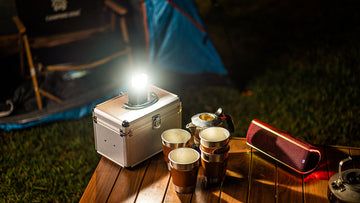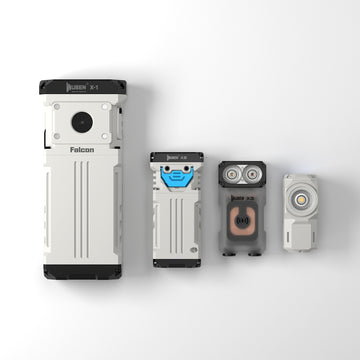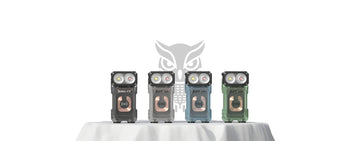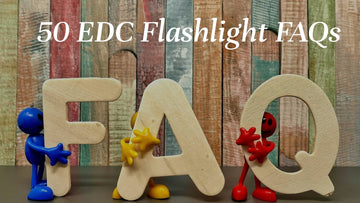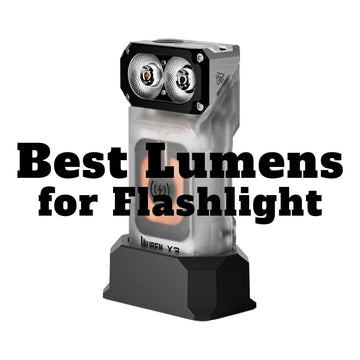
When it comes to choosing a flashlight, the number of lumens plays a crucial role in determining the brightness and overall performance of the device. In the world of flashlights, lumens are the go-to specification for assessing brightness.
Additionally, environmental conditions can impact the effectiveness of a flashlight. In situations with low ambient light or in outdoor settings, higher lumens may be necessary to provide adequate illumination. On the other hand, in confined spaces or situations where preserving night vision is crucial, lower lumens may be more appropriate.
Finding the balance between brightness and battery life is another aspect to consider. Higher lumen flashlights tend to consume more power, resulting in shorter battery life. If you anticipate extended usage or have limited access to power sources, opting for a flashlight with lower lumens and longer battery life might be a wise choice.
Medium Lumens Range (100-500): Flashlights falling into this range offer a good balance between brightness and battery life. They are suitable for general outdoor activities such as camping, hiking, or walking at night. They provide enough illumination for mid-range distances and can handle various tasks efficiently.
High Lumens Range (500+): Flashlights in this range are designed for demanding scenarios that require exceptional brightness and long-range illumination. These include search and rescue operations, tactical situations, and professional use. High lumen flashlights are also effective in lighting up large areas or when dealing with extreme weather conditions.
Everyday carry and general use: For everyday carry or general use, flashlights with medium lumens are typically sufficient. They provide ample brightness for most tasks, such as finding keys in a dark parking lot or walking the dog at night.
Outdoor activities and camping: When engaging in outdoor activities or camping, medium to high lumens flashlights are more appropriate. They offer increased brightness for navigating trails, setting up camp, and providing general illumination in a larger outdoor area.
Tactical and emergency situations: Tactical flashlights or those intended for emergency situations should have high lumens to ensure optimal visibility and potentially disorient adversaries. These flashlights are built to withstand harsh conditions and are often equipped with additional features like strobe mode or SOS signaling.
Understanding the relationship between lumens and beam distance can help in selecting the right flashlight. Generally, higher lumen flashlights tend to have a longer beam distance. However, it is crucial to note that other factors, such as beam intensity and focus, also play a significant role in determining how far the light can reach.
In different scenarios, beam distance can be of varying importance. For instance, in search and rescue operations, a long beam distance is crucial for spotting targets at a distance. On the other hand, in close-quarters situations, a wider beam angle and flood illumination may be more beneficial.
Selecting the best lumens for a flashlight involves understanding your specific needs, the intended use of the flashlight, and the environmental conditions in which it will be used. By considering factors such as brightness, beam distance, and other features, you can make an informed decision that ensures optimal performance and satisfaction for your flashlight needs. Remember, the best lumens for a flashlight are the ones that match your requirements and enhance your overall experience in various situations, from everyday tasks to outdoor adventures and emergencies.
Best Lumens for Your Needs
When choosing the best lumens for a flashlight, it is essential to consider your specific requirements and the intended use of the device. Ask yourself how and where you plan to use the flashlight. Different activities and environments call for varying levels of brightness.Additionally, environmental conditions can impact the effectiveness of a flashlight. In situations with low ambient light or in outdoor settings, higher lumens may be necessary to provide adequate illumination. On the other hand, in confined spaces or situations where preserving night vision is crucial, lower lumens may be more appropriate.
Finding the balance between brightness and battery life is another aspect to consider. Higher lumen flashlights tend to consume more power, resulting in shorter battery life. If you anticipate extended usage or have limited access to power sources, opting for a flashlight with lower lumens and longer battery life might be a wise choice.
Lumens Ranges and Applications
Low Lumens Range (1-100): Flashlights within this range are ideal for close-range tasks that require minimal illumination. These may include reading, finding items in a bag, or navigating through a dark room. They are also suitable for preserving night vision in outdoor settings like stargazing or wildlife observation.Medium Lumens Range (100-500): Flashlights falling into this range offer a good balance between brightness and battery life. They are suitable for general outdoor activities such as camping, hiking, or walking at night. They provide enough illumination for mid-range distances and can handle various tasks efficiently.
High Lumens Range (500+): Flashlights in this range are designed for demanding scenarios that require exceptional brightness and long-range illumination. These include search and rescue operations, tactical situations, and professional use. High lumen flashlights are also effective in lighting up large areas or when dealing with extreme weather conditions.
Lumens for Different Scenes
Now that we have covered the lumens ranges, let's explore how to match lumens to specific activities:Everyday carry and general use: For everyday carry or general use, flashlights with medium lumens are typically sufficient. They provide ample brightness for most tasks, such as finding keys in a dark parking lot or walking the dog at night.
Outdoor activities and camping: When engaging in outdoor activities or camping, medium to high lumens flashlights are more appropriate. They offer increased brightness for navigating trails, setting up camp, and providing general illumination in a larger outdoor area.
Tactical and emergency situations: Tactical flashlights or those intended for emergency situations should have high lumens to ensure optimal visibility and potentially disorient adversaries. These flashlights are built to withstand harsh conditions and are often equipped with additional features like strobe mode or SOS signaling.
The Role of Beam Distance
In addition to lumens, beam distance is an important consideration when choosing a flashlight. Beam distance refers to the maximum range at which the flashlight's beam can effectively illuminate a target. It is influenced by the flashlight's lumen output, beam intensity, and beam focus.Understanding the relationship between lumens and beam distance can help in selecting the right flashlight. Generally, higher lumen flashlights tend to have a longer beam distance. However, it is crucial to note that other factors, such as beam intensity and focus, also play a significant role in determining how far the light can reach.
In different scenarios, beam distance can be of varying importance. For instance, in search and rescue operations, a long beam distance is crucial for spotting targets at a distance. On the other hand, in close-quarters situations, a wider beam angle and flood illumination may be more beneficial.
Selecting the best lumens for a flashlight involves understanding your specific needs, the intended use of the flashlight, and the environmental conditions in which it will be used. By considering factors such as brightness, beam distance, and other features, you can make an informed decision that ensures optimal performance and satisfaction for your flashlight needs. Remember, the best lumens for a flashlight are the ones that match your requirements and enhance your overall experience in various situations, from everyday tasks to outdoor adventures and emergencies.
Tags:
Related Articles

